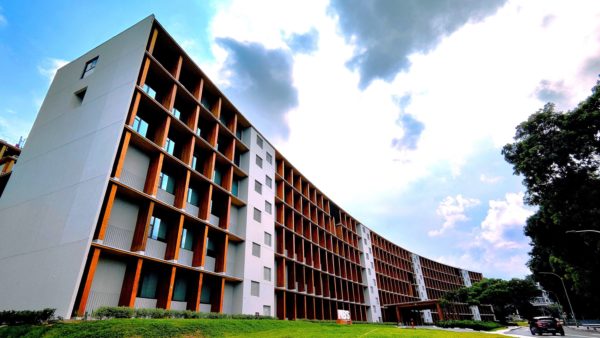The mould found on exterior and interior walls at the mass timber Gaia building at Singapore’s Nanyang Technological University (NTU) is not caused by its timber, but is rather an expected outcome of condensation and exposure to rain, experts have said.
Yesterday, GCR covered a report by Bloomberg speculating whether the mass timber elements made from Austrian spruce were more vulnerable to mould and therefore its cause.
Housing the university’s business school, the 43,500-sq-m building was completed in May last year using more than 7,600 cubic metres of cross-laminated timber (CLT) elements made in Europe by wood supplier Stora Enso.
It contains a 170-seat auditorium, 12 lecture theatres, 13 seminar rooms, and 25 classrooms.
But after assessing the building, two professors from the College of Design and Engineering at the National University of Singapore, who were not involved in the Gaia project, rejected timber as the cause of the mould.
Mould is everywhere here
Associate Professor Tham Kwok Wai, a global expert in indoor air quality and ventilation who chairs the National Committee on Code of Practice for Indoor Air Quality for Air-Conditioned Buildings, said timber used in Gaia didn’t contribute to the mould growth because the timber meets certified regulatory standards and is treated with protective sealants.
He said the mould was mostly found on the air-conditioning supply grilles and furniture surfaces in the affected rooms.
He put it down to condensation, which occurs when the external humid air comes into contact with cooler indoor surfaces, such as when windows and doors of the offices are opened for prolonged periods.
“Moulds are the longest surviving and thriving biological species with millions of years of survival instincts,” Tham said.
“They will sporate more when they are under threat. For example, opening windows will cause them to grow faster as they detect a change in temperature and feel threatened.”
He added that mould is pervasive in Singapore owing to its warm tropical climate, and it can grow on any surface if the environment is conducive, such as in dark, damp, and poorly ventilated areas.
Agreeing with Tham is Associate Professor Shinya Okuda, an expert in the use of timber in buildings and an award-winning architect.
“Mould growth can occur under consistently high relative humidity, prolonged rain exposure, or condensation in tropical environments,” he said.
“More porous surfaces are prone to mould growth, regardless of material – timber or concrete – if untreated.
“The timber elements of Gaia are coated to reduce porosity, which should help mitigate mould growth. However, coatings generally require periodic maintenance.
“The mould growth observed on the exterior timber cladding is due to exposure to direct rain, but the trial sanding that I saw on site shows that mould has not penetrated the timber structure. The long-term mitigation of mould growth involves maintaining a drier environment, reducing condensation and limiting direct rain exposure overall.”
Immediate steps
Tham recommended a number of maintenance approaches, which NTU will implement.
NTU’s chief development and facilities management officer, Siew Hoong Kit, said his team had taken immediate steps to remediate the areas affected by mould and would do comprehensive air quality assessments.
In the next three weeks, rooms and spaces affected by mould will undergo chemical cleaning, followed by mould testing.
Maintenance staff will wipe air-conditioning grilles in all rooms daily.
Spaces and corners that have low airflow will be cleaned monthly.
Exterior and interior building surfaces, including structural pillars, will be inspected and cleaned regularly.
Any visible cracks in wood surfaces will also be patched and resealed to prevent moisture penetration and subsequent mould growth.
NTU will turn on Gaia’s air conditioning system before classes in the morning to ventilate the rooms.
It provides cooled, dehumidified and filtered outdoor air to meet ventilation requirements. This treated air mixes with the room air for a consistent indoor temperature.
NTU further asks building users not to open windows and doors for prolonged periods because it can let external moulds in and cause condensation.
Health concerns
In response to concerns that the mould could cause respiratory problems, two other experts said the immune system normally clears any inhaled fungal spores, and that healthy individuals with normally functioning immune systems are unlikely to experience issues with mould exposure.
Associate Professor Sanjay Chotirmall, Vice Dean of Research at Lee Kong Chian School of Medicine, said: “Not unique to any one building, our humid weather in the tropics does promote fungal growth. Those at higher risk of health-related consequences are usually those with underlying lung disease or allergies including asthma, and those with compromised immune systems, such as patients receiving long-term steroid treatment or chemotherapy for cancer.”
Assistant Professor Loh Jia Tong from the NTU School of Biological Sciences, added: “Mould releases spores, which may cause the immune system of predisposed individuals to overreact. With the deep cleaning and eradication of the mould, most healthy occupants should not experience any issues, especially with the daily maintenance that will inhibit mould growth.”
Pioneers take risks
NTU stood by its decision to use mass timber for Gaia and other buildings, saying that “being a pioneer also means undertaking some inherent risks and moving into uncharted areas”.
It said Gaia had won several international architecture and sustainable building awards, including the highest Green Mark Platinum (Zero Energy) certification.
It said the building produces around 2,500 fewer tonnes of carbon dioxide a year than conventional buildings.
Its rooftop solar plant generates 516,000 kilowatt hours of clean energy to power the building.
Its air-conditioning system saves energy by using passive cooling coils to chill the air without fans.
“We will learn from these challenges and share our learning and best practices as more buildings are constructed using [mass timber] in Singapore and other parts of the tropics,” said facilities chief Siew.
Subscribe here to get stories about construction around the world in your inbox three times a week
Further reading:
The post Timber not to blame for mould at Singapore’s Gaia building, experts say appeared first on Global Construction Review.


